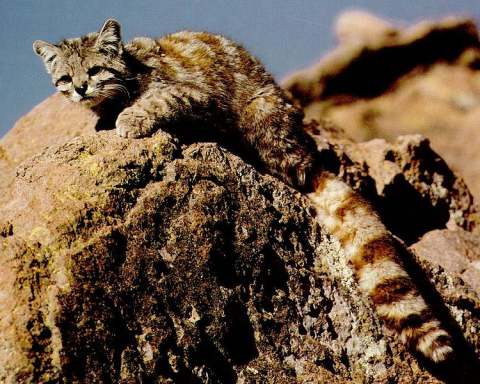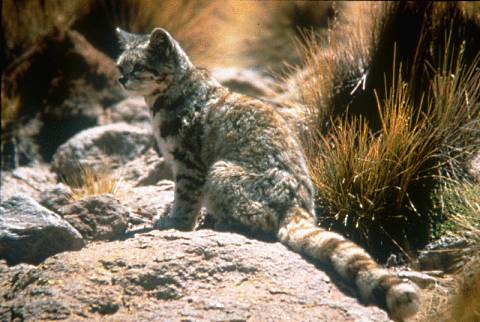
Overview
This article is over 4 pages. There is a link to each page at the base of the page. The page has been refreshed for 2022. The Andean mountain cat (aka ‘Andean cat’) is a small, attractive wild cat with a tabby coat and long tail. It inhabits a rather harsh, cold and barren landscape in the Andes Mountains at around 4,000 meters above sea level. Its population is low at an estimated 2,000. Its primary prey is viscachas; rodents related to chinchillas. The Andean mountain cat allows people to approach. This has facilitated its demise as locals like to kill this cat for ritualistic purposes. Hence the need to get local people involved in its conservation.

Introduction
The Andean mountain cat is yet another wild cat that is either endangered or under threat of entering that fragile classification by the IUCN Red List (see IUCN Red List for Cats). Accordingly, I’ve focused on conservation in this post. PoC has donated $50 to the Andean mountain cat and Small Cats in S. America wildaboutcats.org project. (see Pictures of Cats org Donations).

In 2002 Mel and Fiona Sunquist, the authors of Wild Cats Of The World said that this cat was one of the least known felids in South America. In 2010, Jim Sanderson Ph.D., an expert on this cat species, managed, with his colleagues, the Andean Cat Project in South America and had received the go ahead from the government to create the first Andean cat conservation and monitoring center. This center is located in San Pedro de Atacama, Chile. It is marked on the map, below. Dr. Sanderson worked with the local people to help create a better understanding of the conservation requirements of the Andean cat and there are now at least two large areas within the Andean cat range in which the local people are supportive of its conservation.

RELATED: Footage of elusive Andean cat captured by conservationist: ‘It’s incredible’ – This an interesting page about the Andean cat near Santiago.
Taxonomy
The scientific name is Leopardus jacobita. The genus Leopardus, in which this cat is included, contains most small Neotropical felids. Its inclusion is based on genetic analysis. Although the classification was based in part on a very small number of individual cats. The classification was also based on the size of the auditory chambers in the skull. It is not known how closely it is related to the Pampas cat (src: IUCN Red List of Threatened Species™ – “Red List”).
Population size 2022
Readers should know initially that the latest information that we have about the population size of this small wild cat species is dated 2016. That is the current information and therefore it is live and relevant as at 2022. It is not unusual for information of this sort to be years behind the present.
The experts believe that there are 7-12 Andean mountain cats per every 100 km² in north-western Argentina. In central western Bolivia they believe that there are 1.8 Andean Mountain cat per 100 km². That study is dated 2013.
At 2016 they believe that the number of mature individuals is: 1378. The numbers continue to decrease. The population is severely fragmented. They believe that there are 10 subpopulations. They also believe that because of the severe fragmentation of their distribution there may be special adaptations in these areas. The number of individuals in the largest subpopulation has been estimated to be 172.
As mentioned, the numbers are very low (not untypical for wild cats, sadly). Although the Pampas cat, a close relative, is similar in appearance in the high Andes, the Andean cat is much rarer. Apparently, the local people have difficulty distinguishing the Pampas cat from the Andean cat. This may prove important as they are killed sometimes for what can only be regarded in modern times as superstitious reasons (education is the answer, see below). There is a lower genetic diversity in this cat species compared to the Pampas cat (see Cat Inbreeding Means Poor Sperm). A population estimate was one cat per 5 square kilometers (25,000 ha area in northern Chile). There are none in captivity as far as is known.
NOTE: THIS IS A 4 PAGE ARTICLE! SEE THE PAGE LINKS BELOW.

Andean Cat – Photograph copyright Jim Sanderson, Ph.D.


I think you are right. I uploaded that ages ago. I’ll change it now and thanks.
I think that’s actually a pampas cat in the first picture. I see them get confused with Andean mountain cats alot.
Sincere apologies for the typo. Working at speed is the problem. I have corrected it and thanks for allowing me to use it. Copyright is dead on the internet in my view because Pinterest and Google Images destroyed it as a legal concept.
You can use my picture, but please spell my name right. Thank you